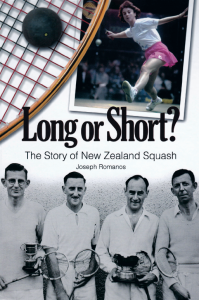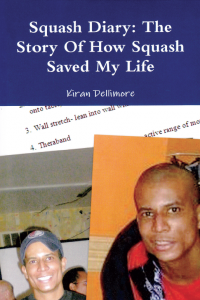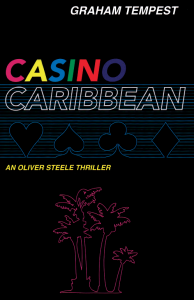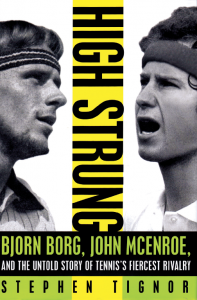By James Zug
It is that time of year again. In between Labor Day and New Year’s, the vast majority of books are published. Since squash players are intensely literary as a rule, here is a guide to the books every squash player should know about and own and talk about with opponents after the last game. And don’t worry, the favorite squash book of 2011, Run to the Roar, has some good news: it is coming out in paperback next February.
Prides Crossing: The Unbridled Life and Impatient Times of Eleonara Sears
Peggy Miller Franck
(Beverly, Mass: Commonwealth Editions, 2009)
 Eleo Sears was America’s pioneering squash woman. She was good. She won the first national championship in 1928 (at the age of 46) and four Massachusetts state titles (the last at age 56, over her longtime nemesis Margaret Howe). She entered and won matches in open tournaments well into her seventies.
Eleo Sears was America’s pioneering squash woman. She was good. She won the first national championship in 1928 (at the age of 46) and four Massachusetts state titles (the last at age 56, over her longtime nemesis Margaret Howe). She entered and won matches in open tournaments well into her seventies.
Sears served as president of the U.S. women’s squash association for a record 13 years and was the captain of the U.S. team on their first overseas tours, to England in the Wolfe-Noel Cup. She opened up the formerly all-male game in America, persuading Harvard to allow women to use their courts and becoming a catalyst for opening up all-male clubs in Boston. She embodied women’s squash.
But squash was a tiny star in Sears’ incredible feminist firmament. One of the greatest athletes in history, she was known, in the words of a New Yorker writer, as “the first of the outdoor girls.” In tennis she won five doubles titles at the U.S. nationals (four women’s, one mixed), lost in the finals of the singles once and was inducted into the International Tennis Hall of Fame in 1968. She was the first woman to play polo front-saddle and wearing pants. She maintained a thorough-bred racing stable and competed for fifty straight years in the National Horse Show—she was elected to the Show Jumping Hall of Fame in 1992.
Most famously, Sears popularized the sport of long-distance pedestrianism and did some epic walks. She footed it from San Francisco to Los Angeles, from Boston to New York, from Fontainebleau to Paris. She annually walked from Providence to Boston, clocking in under ten hours. She once hiked from Newport to Boston (seventy-four miles) in just over seventeen hours.
Sears was a massive celebrity, one of the most quoted and reported upon women in the country. The great great grand-daughter of Thomas Jefferson and a true-blue Boston Brahmin, Sears was often in the newspapers. She got arrested for smoking in the Copley Square Hotel (only men could smoke there at the time). She rode a horse into the Lenox, Mass., post office to mail a letter. During the hurricane of 1938 she was walking to have tea on Cape Cod; caught in an enormous storm surge, Sears calmly swam her way through the surf and into her host’s second-floor window. Prides Crossing, the Massachusetts village, near Beverly, was where Sears had her country home, apparently obtained by winning a backgammon game.
Until now there has been no biography of this trailblazing woman. Franck, the daughter of Sears’ longtime business advisor and racing-stable manager, grew up with Sears and has great insight into the woman. She also has some amusing squash stories. For decades, Sears played regularly with Jack Summers, the Union Boat Club pro and national pro champion. She never paid him for any of the lessons, but presented him with a new car every two years. In London Sears introduced Tallulah Bankhead to the U.S. team in the Wolfe-Noel Cup. The actress greeted the team by doing a cartwheel and standing on her head—she was naked underneath her dress.
Blurbed by Ben Bradlee and Bud Collins, Prides Crossing is a well-researched, delightful and necessary addition to the story of U.S. squash.
Long or Short?: The Story of New Zealand Squash
Joseph Romanos
(Waitakere, New Zealand: New Zealand Squash Hall of Fame, 2010)
 This is probably the largest squash book in history. It is a heavy, coffee-table book and hundreds of photographs are jammed into its 328 pages. There is a lengthy appendix and index.
This is probably the largest squash book in history. It is a heavy, coffee-table book and hundreds of photographs are jammed into its 328 pages. There is a lengthy appendix and index.
Romanos was a top amateur player in New Zealand who coached for a year at a club in Germany. A longtime sports journalist, he has written 40 books, so this has a nice, accessible feel to it.
I was wrong what I wrote in my book, Squash: A History of the Game. New Zealand’s first courts, in Christchurch (1907) and Wellington (1913), were the size of the narrow American hard-ball court and not converted to British standards for decades. (I had written that they were 21-footers but that the Kiwis used an American-style hardball on them.) Although Romanos doesn’t discuss why the first courts had that narrow width, it is instructive to again recall how widely variant court sizes were around the world in those early years when the game, outside the U.S., was not standardized.
Some interesting comparisons to the history of the American game: New Zealand’s first court (1907), association founded (1932), first national junior championship (1950), first national women’s championship (1951) and first nationals not in all-white clothing (1983).
Oddities: it was not until 1959 that a stroke was awarded in New Zealand play (before it was always just a let). A club in Napier had half a wall between the men and women’s locker rooms and showering players would often lend soap over the wall to each other. In 1959 Palmerston North hosted an exhibition with a portable court—since the glass wall had not been invented yet, they used chicken wire for a back wall; ten years later in Wellington a company unveiled a fold-up court. A farmer in Maketu put up a concrete brick court with a corrugated iron roof; built right next to the milking shed, it had occasional visits from the cattle if the door was left open. Another court in Otamauri was built from a fertilizer bin.
For a tiny, remote nation, New Zealand has played an out-sized role in international squash, especially in the 1980s. At that time, Kiwis were running the WSF and WISPA, and Susan Devoy and Ross Norman were winning world championships. There is a great photo in the book of Norman in a hospital bed after his parachuting accident in 1983, three years before he toppled Jahangir Khan in the famous Toulouse final.
The quirky title comes from the Kiwi lingo for the question that would arise when a game reached 8-all, “long” being what we in America call “set two.”
Squash Diary: The Story of How Squash Saved My Life
Kiran Dellimore
(Lulu.com, 2010)
 Dellimore has self-published a fascinating memoir. In the form of a diary, it covers the year or so after a car slammed into him in March 2007 while he was walking along a roadside near the University of Maryland in College Park. In the hit-and-run accident, he was knocked unconscious and left with a broken arm and leg.
Dellimore has self-published a fascinating memoir. In the form of a diary, it covers the year or so after a car slammed into him in March 2007 while he was walking along a roadside near the University of Maryland in College Park. In the hit-and-run accident, he was knocked unconscious and left with a broken arm and leg.
Born and raised in Barbados, Dellimore came to the States ten years earlier to attend Morehouse College. He earned his Ph.D. in aerospace engineering from U of M, where he first picked up squash. After the accident, Dellimore began playing again. He managed in a year’s time to fully recover and win the Division III title at the 2008 Fischer Cup (the Washington district championships).
The diary’s view is very tight and close-up, so you follow closely along as Dellimore wins and loses against his sparring partners and prepares for tournaments. He also lightly but insightfully comments upon racism in American squash.
A month after he published Squash Diary, Dellimore moved to South Africa. He is based at Stellenbosch University doing a postdoc and playing league squash.
Casino Caribbean: An Oliver Steele Thriller
Graham Tempest
(Apopka, Fla: Brightway Publishing, 2010)
 Jeremy Stone, writing under the pen name Graham Tempest, wrote this murder mystery. It is a taut, suspenseful story involving Internet gambling. The action roams from Fort Lauderdale to Newcastle but mostly is set in the Caribbean.
Jeremy Stone, writing under the pen name Graham Tempest, wrote this murder mystery. It is a taut, suspenseful story involving Internet gambling. The action roams from Fort Lauderdale to Newcastle but mostly is set in the Caribbean.
There is barely a sniff of squash in the novel, but Stone, a retired accountant, is a well-known squashman. He started playing as a schoolboy in Watlington, the Oxfordshire village where he grew up: his first court was in a barn. As a teenager, he played at a boarding school where most of the courts had stone floors and were several feet longer in length than the standard 32 feet; he played at Cambridge. In 1976 he moved to Los Angeles and joined the South Bay Squash Club, the classic old club in Torrance, with its sideways floorboards. He was president of the Southern California SRA in the late Eighties and produced an illustrated newsletter in which he wrote, as he said, “a scurrilous, anonymous column by I. Nick Atwill who attacked everyone indiscriminately and occasionally truthfully.” Stone organized two notoriously uproarious SCSRA tours, in 1994 to the Far East and India in 1997. He is now retired to Florida, outside Orlando, and Watlington and still plays regularly.
The next Oliver Steele novel, Casino Excelsior, will be out in June 2012. Stone has promised more squash this time.
High Strung: Bjorn Borg, John McEnroe and the Untold Story of Tennis’s Fiercest Rivalry
Stephen Tignor
(New York: HarperCollins, 2011)
 There is no squash whatsoever in this book, but High Strung so clearly and imaginatively sums up the conflicts that deeply affected squash as well. The transition between amateurs and professionals, the old guard and new money, the private clubs and the new burgeoning pro tour—this is the core of the book and what so perfectly relates to the 1970s and 80s in squash. Reading this book, pictures pop into your head, Stu Goldstein in his Fila outfits or the angst-filled battles between Vic Niederhoffer and Sharif Khan, a mercurial flash like Mike Desaulniers, the rise of Mark Talbott.
There is no squash whatsoever in this book, but High Strung so clearly and imaginatively sums up the conflicts that deeply affected squash as well. The transition between amateurs and professionals, the old guard and new money, the private clubs and the new burgeoning pro tour—this is the core of the book and what so perfectly relates to the 1970s and 80s in squash. Reading this book, pictures pop into your head, Stu Goldstein in his Fila outfits or the angst-filled battles between Vic Niederhoffer and Sharif Khan, a mercurial flash like Mike Desaulniers, the rise of Mark Talbott.
For tennis fans, there are a ton of wonderfully etched portraits of the personalities of the golden era, I knew the rumor that Ivan Lendl would have the contractors who resurfaced the U.S. Open courts at Flushing Meadows every spring come to his private court to redo his the same way. Tignor reports that Lendl had the guys come over the day after they finished at Flushing so they’d remember the exact mixtures. (Lendl reached the final a record eight straight times.)
High Strung is tuned perfectly.





